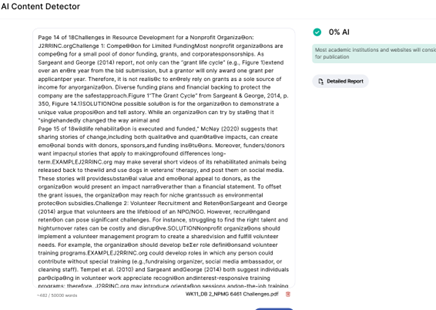Challenges in Resource Development for a Nonprofit Organization: J2RRINC.org
Challenge 1: Competition for Limited Funding
Most nonprofit organizations are competing for a small pool of donor funding, grants, and corporate sponsorships. As Sargeant and George (2014) report, not only can the “GRANT LIFE CYCLE” (e.g., Figure 1) extend over an entire year from the bid submission, but a grantor will only award one grant per applicant per year. Therefore, it is not realistic to entirely rely on grants as a sole source of income for any organization. Diverse funding plans and financial backing to protect the company are the safest approach.
SOLUTION
One possible solution is for the organization to demonstrate a unique value proposition and tell a story. While an organization can try by stating that it “single-handedly changed the way animal and wildlife rehabilitation is executed and funded,” McNay (2020) suggests that sharing stories of change, including both qualitative and quantitative impacts, can create emotional bonds with donors, sponsors, and funding institutions. Moreover, funders/donors want impactful stories that apply to making profound differences long-term.
EXAMPLE
J2RRINC.org may make several short videos of its rehabilitated animals being released back to the wild and use dogs in veterans’ therapy, and post them on social media. These stories will provide substantial value and emotional appeal to donors, as the organization would present an impact narrative rather than a financial statement. To offset the grant issues, the organization may reach for niche grants such as environmental protection subsidies.
Challenge 2: Volunteer Recruitment and Retention
Sargeant and George (2014) argue that volunteers are the lifeblood of an NPO/NGO. However, recruiting and retention can pose significant challenges. For instance, struggling to find the right talent and high turnover rates can be costly and disruptive.
SOLUTION
Nonprofit organizations should implement a volunteer management program to create a shared vision and fulfill volunteer needs. For example, the organization should develop better role definitions and volunteer training programs.
EXAMPLE
J2RRINC.org could develop roles in which any person could contribute without special training (e.g., fundraising organizer, social media ambassador, or cleaning staff). Tempel et al. (2010) and Sargeant and George (2014) both suggest individuals participating in volunteer work appreciate recognition and interest-responsive training programs; therefore, J2RRINC.org may introduce orientation sessions and on-the-job training for future volunteers.
In conclusion, limited funding and volunteer recruitment/retention are the leading challenges for resource development. By establishing a unique value proposition and implementing structured volunteer management systems, J2RRINC.org and other nonprofit organizations can address these challenges, securing a reliable income all the while creating a sustainable impact.
References
McNay, L. W. (2020). Eight fundraising trends for 2020. AFP Global. https://afpglobal.org/eight-fundraising-trends-2020
Sargeant, A., & Jay, E. (2014). Fundraising management: Analysis, planning and practice (4th ed.). Routledge. https://bookshelf.vitalsource.com/home/my-library?context=login
Tempel, E. R., Seiler, T. L., & Aldrich, E. E. (Eds .). (2010). Achieving excellence in fundraising (3rd ed.). Jossey-Bass. https://ebookcentral.proquest.com/lib/waldenu/detail.action?docID=624350
JustDone AI CONTENT DETECTOR = 100% Human


